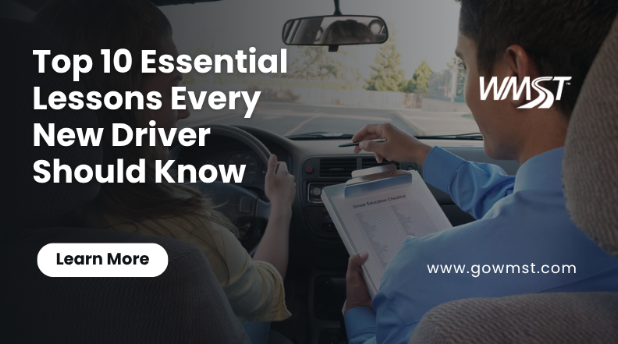The Foundation of Safe and Confident Driving
Before diving into specific lessons, it’s important to establish the core values of safe and confident driving: awareness, consistency, and control. These fundamentals—developed through structured training, supportive instruction, and practice—help new drivers make smart decisions and stay calm in unexpected situations.
Top 10 Lessons Every Beginner Must Learn
- Understanding Basic Road Signs
Mastering speed limits, yield/stopping rules, and warning signs sets the stage for all safe behavior. In Washington State, you’ll frequently encounter 25 mph zone signs, so knowing them is critical. - Controlling Speed and Spacing
Learn how to adjust speed smoothly and use a safe following distance—the 4‑second rule—to maintain enough reaction time and reduce crash risk. - Mastering Turns and Lane Changes
Practice signaling and executing smooth turns and lane changes. Remember: while lane changes through intersections aren’t illegal in Washington, they come with tighter space and risk, so caution and timing matter. - Using Mirrors and Blind Spot Checks
Habitual mirror checks and quick shoulder glances are essential for avoiding collisions, especially in heavy traffic or during lane changes. - Tested Maneuvers
Essential maneuvers required on the skills test include parallel parking, hill parking, lane changes, entering and exiting traffic and backing around a corner. Regular supervised practice builds confidence. - Night and Bad Weather Driving
Fog, rain, and darkness affect visibility and control. Learn strategies like reduced speed, increased spacing, and cautious turning. - Navigating Roundabouts and Intersections
Understand the rules of right‑of‑way and proper lane use. Safe navigation of these complex areas significantly lowers risk. - Emergency Braking and Skid Recovery
Learn how to brake firmly—without locking—and regain control during skids, especially on wet or icy roads. - Sharing the Road with Others
Respect for pedestrians, cyclists, and other drivers—while anticipating their actions—is key to preventing conflicts on shared roads. - Defensive Driving and Hazard Awareness
Adopt a proactive mindset by scanning ahead, identifying potential dangers, and maintaining focus on the driving environment. Visit https://gowmst.com/.
How to Practice These Skills After Class
- Schedule supervised driving sessions with a licensed adult and a clear practice plan.
- Use a progress journal to track areas like mirror use, turns, and parking accuracy.
- Simulate test conditions (e.g., parallel parking in a quiet parking lot) before taking the skills test.
- Increase exposure gradually—start with quiet roads before moving on to highways or nighttime driving.
Mistakes to Avoid as a New Driver
- Overlooking mirror checks or blind spots.
- Rushing maneuvers, especially during parking or lane changes.
- Tailgating—never sacrifice the 4‑second rule.
- Ignoring changing conditions like weather or visibility.
- Skipping practice with parental supervision or an instructor.
Building Good Habits from the Start
- Consistency is key: repeat safe behaviors until they become automatic.
- Stay calm and patient: emotional self-control prevents risky decisions.
- Keep learning: follow official updates via the Washington Driver Guide.
- Seek feedback: ask instructors or supervisors for real-time insights whenever possible.
FAQs
How can new drivers improve their skills outside of class?
Practice deliberately with goals in mind, keep a log of what to improve, and drive in varying conditions.
Do all driving schools cover these 10 lessons?
Certified schools like WMST cover all these essentials—and reinforce them through six hours of hands-on training.
How long does it take to master the basics of driving?
It varies by learner, but consistent practice over several weeks usually leads to proficiency in foundational skills.
What mistakes should new drivers avoid during practice?
Avoid rushing maneuvers, neglecting mirror checks, tailgating, and ignoring triggers of emotional driving.
What’s the most important driving lesson for beginners?
Maintaining awareness—through mirror use, scanning ahead, and accounting for hazards—forms the backbone of safe driving.
Conclusion
By focusing on these essential driving lessons for new drivers, individuals can develop solid, lifelong habits that promote safety, confidence, and responsibility. With structured support from certified schools like WMST and regular supervised practice, new drivers are better equipped to handle the road ahead skillfully, calmly, and safely.


